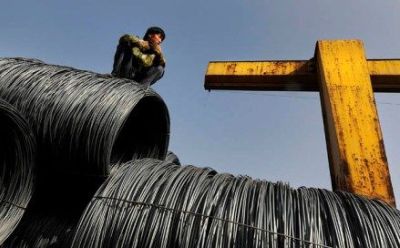

Cover lead, issue 434, August 31, 2009
Translated by Liu Peng
Original article:[Chinese] 
As the gradual roll out of the country's 4-trillion yuan stimulus package starts to take effect on the Chinese economy, overcapacity has once again become a serious problem for policy makers.
In late August, Chinese premier Wen Jiabao presided over an executive meeting of the State Council which ordered moves be taken to curb overcapacity and the presence of duplicate projects that exist in certain sectors.
The meeting produced a list of products that had already reached overcapacity, namely: steel, textiles (spun yarn), electrolytic aluminum, cement, plate glass, caustic soda (used by the chlor-alkali sector to produce PVC), chemically-processed coal, alumina (an aluminum oxide used to improve the durability of the light metal), shipbuilding and industrial chemicals.
The State Council, along with similar lists produced by the National Development and Reform Commission (NDRC) and the Ministry of Industry and Information Technology (MIIT), also mentioned problems of overcapacity in products used in China's new energy sector, including the crystalline silicon used in the production of solar cells and turbines used in the generation of wind power.
In order to deal with the problems caused by overcapacity, the State Council has charged authorities with strictly enforcing limits to market access, intensifying environment supervision and strictly controlling land supply for any new projects in these selected industries.
Overcapacity first found its way on to the State Council's agenda in late 2005. At that time, ten industries including, steel, electrolytic aluminium, calcium carbide, ferroalloys, coke, automobiles, cement, coal, electricity and textiles were categorized as exhibiting evidence of overcapacity.
According to a recent report authored by the Financial and Economic Affairs Committee (FEAC) of the National People's Congress (NPC), nineteen industries are currently plagued by problems of overcapacity, although the report failed to provide a detailed list.
The number of industries effected has almost doubled in the period since the State Council first began addressing the problem of overcapacity back in 2005.
Problems of Overcapacity
The FEAC report noted that when the new round of stimulus package investment was unleashed last October, local governments expanded production capacity with no regard for the consequences and some projects were constructed without preliminary assessment or approval from higher authorities.
These actions further aggravated the existing problems of overcapacity that existed in certain industrial sectors.
Production of steel, cement and electric power were highlighted by the report as being representatives of this kind of unconsidered expansion.
For example, data revealed that China's annual crude steel output reached 660 million tons by the end of 2008; however, according to official projections, domestic demand was less then 500 million tons.
Despite repeated attempts to eliminate outdated steel facilities since 2005, crude steel output managed to post continuous growth over recent years with output rising by 69.91 million tons, 70.09 million tons and 71 million tons over the three years that followed the crackdown.
The cement industry also faced similar problems. According to official data, production of cement in 2008 exceeded domestic demand by 300 million tons. However, investment in cement in the first half of this year registered a year-on-year increase of 78.6%.
At present, over 200 cement production lines are under construction, they will result in more than 200 billion tons of additional production capacity, according to a report from the MIIT.
An official from the National Development and Reform Commission (NDRC), China's top economic planner, admitted that local governments favoured the construction of large industrial projects. He went on to say that part of the reason why these large projects were built is that they were the result of impulsive investments by local governments that suddenly had access to easy money, but he also explained that they'd often purposefully split the large projects into smaller schemes in order to avoid requiring approval from the NDRC.
Liu Manping, a researcher at NDRC's price monitoring center, ascribed overcapacity to the country's investment-driven economic growth model.
In response to the crisis, investment has become the engine being used to pull the country out of the economic doldrums.
In the first seven months of this year, urban fixed asset investment rose 32.9% from a year earlier, a much higher rate of growth than in previous years. Investment's contribution to the country's economic growth reached 87.6%
However, this increase in investment has led to an increase in productive capacity that has emerged at a time when overseas demand is weak. Thus consumption is not able to absorb the amount of new output produced and problems of excess capacity are exacerbated.
Liu pointed out that monetary policy was another factor that affected investment in certain industries. In the past few years, whenever credit policy was loose and money could be lent at cheap rates, the steel industry continued to expand production capacity.
In the first seven months of 2009, Chinese banks extend a record 7.73 trillion yuan of new loans. Of these loans, most flowed to government-led projects, which, in turn, resulted in the expansion of industries that were already plagued by problems of overcapacity, Liu added. 
Overcapacity in the Solar and Wind Energy Sectors
According to the FEAC report, wind and solar power projects across the country were also beginning to encounter problems including unnecessary duplication of projects due to a huge rush to invest in the sector.
Meng Xiangan, vice chairman of Chinese Renewable Energy Society, said at the moment, the wind power industry was experiencing a small degree of overheating.
At present, China has over 70 wind power equipment manufacturing factories, the output of which has already exceeded domestic market demand. Although the quality of much of the equipment being produced has not yet been put to the test.
With respect to the solar power industry, the production of crystalline silicon (which is used to make solar cells) has only really taken off in the last year. The EO aggregated the production targets of the various manufacturers in the industry, and calculated that if they meet these targets, over the next eleven years China will produce somewhere between 50,000 and 100,000 tons of crystalline silicon - effectively satisfying global demand.
However, not everyone agrees that there are problems with overcapacity in the sector.
Peng Xiaofeng, chairman of LDK Solar, a well-known domestic solar wafer producer, held that the central government's warning about overcapacity in the poly silicon industry was targeted at those firms with outdated production facilities that produce excessive pollution.
"The poly silicon industry in China is still in its infancy, and the country still lacks any large poly silicon manufacturing firms that are capable of catching up with world leaders" he added.
Difficulty in Curbing Overcapacity
In it's latest efforts to curb overcapacity, the State Council has instructed officials to strictly enforce limits on market access to certain industries, intensify environment supervision and strictly control land supply for any new projects in the industries concerned.
In fact, the central ministries and commissions adopted similar measures when clamping down on overcapacity over the past three years, however, the measures haven't proved very effective in curbing the expansion of the troubled industries.
An official with MIIT said "Besides the three measures proposed by the State Council, credit and market exit mechanisms would also be adopted to help eliminate outdated production facilities."
He also revealed that eliminating outdated production facilities needed to appropriately address the concerns of local governments, as some companies effectively propped up local economies and were both a major source of tax revenue for local governments and a major source of employment in the area.
Without a reasonable exit strategy, local governments would not be motivated to eliminate outdated production facilities, he added.
The FEAC report similarly attributed difficulties in effectively dealing with overcapacity to the lack of a feasible market exit mechanism for local industries.
Meanwhile, the report also noted that the elimination of outdated production facilities in the past three years has relied mainly on administrative measures (direct orders to close) rather than economic measures.
However these measures have also had a limited impact.
Chen Ling, deputy-director of China's Metallurgical Economic Research & Development Center, recalled that at the start of the campaign against overcapacity in the steel industry, the government ordered producers with blast furnaces smaller than 200 cubic meters to close their doors.
Upon hearing such news, many small steel mills simply upgraded their blast furnace so that they now use 300 cubic meters, or even larger, blast furnaces. Later, the government again raised the cut-off to 300 cubic meters, said Chen, but by continuing to increase the size of the blast furnace limit, the government simply pressured steel makers to once again enlarge their blast furnaces and thus production capacity continued to expand.
Links and Sources
Netease: Image
Gov.cn: State Council Meeting Report (Chinese)

